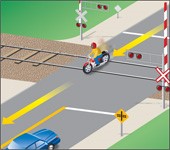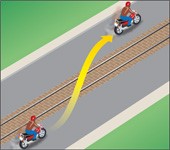Driving on dangerous surfaces
Because motorcycles and mopeds balance on only two wheels, those two wheels must have good traction in order to stay upright. Any surface that affects your motorcycle or moped’s traction will affect the steering, braking and balance. Slippery surfaces reduce your control and increase your chances of falling. It is almost impossible to keep your motorcycle or moped balanced on wet wooden surfaces or ice. If you cannot avoid such surfaces, slow down as much as possible before you get there. Do not brake once on the slippery surface. If you are riding a motorcycle with a clutch and gears, pull in the clutch and coast across.
Pulling in the clutch removes the engine drag from the rear wheel and helps avoid skidding. Stay off the brakes. If necessary, use your foot to hold the motorcycle up.
Watch for uneven road surfaces such as bumps, broken pavement, potholes, railroad tracks and construction areas. If the condition of the road is bad enough, it could affect your control of your vehicle. Here are some tips on handling uneven surfaces:
- Slow down to reduce the impact.
- Keep your motorcycle or moped as upright as possible and avoid turning.
- Rise slightly on the footrests so that you can absorb the shock with your knees and elbows.
Traction on gravel roads is not as good as on pavement. Some areas are better than others. Stay in the tire tracks away from the loose gravel at the edge of the road.
Drive with extra care in a construction area. Slow down; the road could have ruts, mud or damaged pavement.
Stopping at a railway crossing
All railway crossings on public roads in Ontario are marked with large red and white “X” signs. Watch for these signs and be prepared to stop. You may also see yellow advance warning signs and large “X” pavement markings ahead of railway crossings. Some railway crossings have flashing signal lights and some use gates or barriers to keep drivers from crossing the tracks when a train is coming. Some less-travelled crossings have stop signs posted. On private roads, railway crossings may not be marked, so watch carefully. When you come to a railway crossing, remember the following:

- Slow down, listen and look both ways to make sure the way is clear before crossing the tracks.
- It can take up to two kilometres for a train to stop under full emergency braking.
- If a train is coming, stop at least five metres from the nearest rail or gate. Do not cross the track until you are sure the train or trains have passed.
- Never race a train to a crossing.
- If there are signal lights, wait until they stop flashing and, if the crossing has a gate or barrier, wait until it rises before you cross the tracks.
- Never drive around, under or through a railway gate or barrier while it is down, being lowered or being raised. It is illegal and dangerous.
- Avoid stopping in the middle of railway tracks. Make sure you have enough room to cross the tracks completely before you begin to cross.
- Avoid shifting gears while crossing tracks.
- If you get trapped on a crossing, immediately leave your vehicle and move to a safe place, then contact authorities.
- Buses and other public vehicles are required to stop at railway crossings that are not protected by gates, signal lights or a stop sign. School buses must stop at railway crossings whether or not they are protected by gates or signal lights. Watch for these vehicles, and be prepared to stop behind them.
- If you are approaching a railway crossing with a stop sign, you must stop unless otherwise directed by a flagman.
It is usually not necessary to change your path when crossing railway tracks that run across (perpendicular to) the road. Be prepared for a bump and avoid braking or turning while on the tracks. Railway and streetcar tracks are extremely slippery.
When you want to cross railroad or streetcar tracks that run parallel to your path, cross at a distinct angle (no less than 45 degrees) to prevent getting stuck in the tracks or losing control. Do not try to edge across the tracks or brake heavily. Do the same thing when crossing other uneven surfaces such as a pavement seams or a gravel shoulder.

Grooves, gratings and scraped roads
When you drive over certain surfaces, such as grooved or rutted pavement or metal bridge gratings, you may feel as though you are losing control of your motorcycle or moped. This effect is greater on smaller vehicles than it is on larger ones; the smaller your vehicle, the larger the effect. Avoid overreacting. Keep a gentle but firm grip on the handlebars and drive as smoothly as you can, choosing the best route possible until you get back on a good surface.